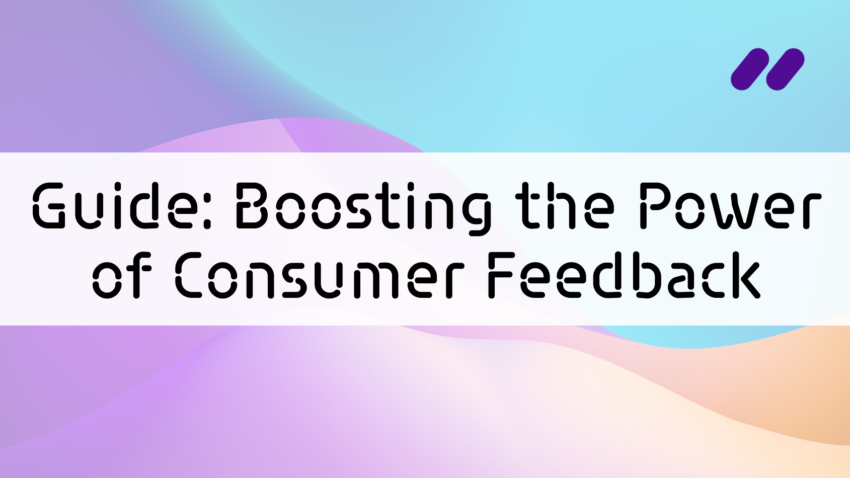Consumer feedback is and always has been a powerful tool for improving products, service and customer experience. Today, the impact of COVID-19 across the retail and CPG sectors has made consumer feedback more important than ever. At the same time, feedback data has become more accessible, plentiful and packed with information on consumer behaviour—organizations simply need the right tools to uncover valuable insights within the data.
1. Where feedback data fits in
Meeting consumer needs has become more complex with advances in technology, social media engagement and the increased number of consumer channels. At the same time, all that change has resulted in a wealth of data. One of the biggest questions now is how to harness that data to uncover actionable insights into consumer behaviour. New data analysis technologies have made the link between consumer feedback and a company’s bottom line even more clear.
In an era rich with data, businesses in almost every industry are working hard to “unleash the power of data” across every part of their organization. To learn more about what consumers think of products, services and brands, organizations need to implement dynamic instrumentation for listening to customers, learning from them and reflecting consumer priorities within brands and companies themselves. As part of a broader organizational data strategy, that results in the kind of actionable intelligence that helps key decision makers and stakeholders make better, faster decisions.
Trust in the eCommerce era
Word of mouth has been around for centuries: people have always looked to their peers’ opinions and experiences when making a decision about something they’re unfamiliar with. When consumers are trying to figure out what products or services will suit them best and whether to purchase, they show this same innate need for trustworthy information. That hasn’t changed with the growth of digital channels and eCommerce. In fact, the power of word of mouth has become a driving force behind consumer decision making.
In a post-pandemic world, where the in-person shopping experience has drastically changed and the adoption of online shopping has accelerated, consumers rely even more on online peer reviews to make their purchasing decisions.
Instead of picking up the phone to call a colleague or talking over coffee with a trusted friend, people more often turn to the internet—particularly social networks—as their source for trusted opinions, reviews and advice when shopping for any type of item.
These trusted words from online strangers have become an incredibly important part of the buying process:
- 95% of consumers read online reviews before making a purchase.
- 76% of consumers trust online reviews as much as recommendations from family and friends, while 91% of consumers ages 18-34 trust online reviews just as much as personal recommendations.
- That same research shows that the average consumer reads 10 reviews before they feel they can trust a business.
- And those consumers spend 13 minutes and 45 seconds reading reviews before making their decision.
Post-pandemic consumer trends
Needless to say, reviews play a crucial role in driving sales in today’s hyperconnected, multi-channel landscape. In a post-pandemic world, where the in-person shopping experience has drastically changed and the adoption of online shopping has accelerated, consumers rely even more on online peer reviews to make their purchasing decisions.
From April 2020, researchers have measured:
- a 129% year-over-year growth in U.S. & Canadian e-commerce orders, and
- a 146% growth in all online retail orders.
Engagement with reviews has climbed in line with increased online sales volumes, with shoppers heavily relying on review content to make purchasing decisions, especially when it comes to products they haven’t previously had to buy before, online or otherwise.
When consumers are less inclined to go into a store to physically experience, inspect and research a product, they turn to the next best thing: online reviews. As brands plan for the future, it’s important to pay attention to these new trends that are set to outlive COVID-19.
Leveraging quality consumer feedback to drive sales
As people increasingly rely on ratings and reviews to justify their purchasing decisions, companies should be giving consumer feedback the same weight as their customers do. How a company drives and leverages consumer feedback can be completely customized, including how the company engages with and relates to customers, what marketing and service channels encourage customer feedback, and how easy it is for customers to give feedback.
To get the most from feedback data:
- choose the right method of collection,
- choose a syndication platform,
- study the findings.
Collect feedback data using:
- Post-interaction emails
- Product sampling
- Contests and sweepstakes
- Online reviews
- Social media interactions
Optimize current channels, including product surveys, ratings and reviews, social engagement and product testing by asking the following questions:
- Are current marketing channels efficient and approachable from a consumer feedback perspective?
- Can you deploy product surveys to get quick feedback?
- Do you have a place that syndicates and analyzes the survey data you collect?
- Can consumers share their reviews and your product with friends and family on their social channels?
2. Where feedback begins: Trying, testing, sampling
The value of consumer feedback for engaging consumers, understanding customer behaviour, and driving sales during a pandemic is clear. And while gathering and analyzing a diversity of high-quality feedback has become much faster and easier thanks to new technologies, what about getting products into customers’ hands these days?
Prior to the pandemic, companies had several avenues for consumers to trial or purchase samples of their products: in-store and online sampling, experiential marketing plays, store promotions and more. With brand representatives and customers alike spending much more time inside their homes, getting products to consumers for testing—and in turn, receiving authentic feedback—has become a bigger challenge.
Fostering relationships from a distance
Instead of pulling back on marketing spend, brands need to reach consumers wherever they’re at, whether that’s at home online, in transit or on their lunch break at the office. Creating and maintaining genuine relationships with consumers while fostering brand advocacy requires diversifying the marketing mix and opening more direct lines of communication.
One of the ways that brands can reach and engage their targeted consumers from a distance and in a memorable way is by simply putting their products into their hands. By leveraging digital product sampling, brands can target consumers online and deliver product samples directly to doorsteps, allowing customers to physically experience the brand from the comfort (and safety) of their own homes. Personalized sample-matching and delivery company Sampler has found that 1 in 4 consumers who get a free sample leave a review of the product.
Increase the likelihood of receiving reviews by optimizing all feedback channels to:
- Allow for consumers to try a product,
- Easily leave reviews,
- Share feedback with friends.
Free samples = major feedback
By leveraging digital product sampling, brands can target consumers online and deliver product samples directly to doorsteps, allowing customers to physically experience the brand from the comfort (and safety) of their own homes.
Companies can also integrate product sampling into current marketing channels by adding a sampling CTA to existing ads or influencer marketing campaigns. These are just two ways to populate ratings and reviews quickly for new items or to refresh the reviews on established SKUs.
For example, o.b. decided to address a millennial target audience by focusing on tampon users who were new to o.b.’s non-applicator product. The brand launched social media ads and influencer video segments in tandem to promote their free product offer. They used digital product sampling to gather product feedback and sentiments from trial users on their experience.
Some key results from the o.b. strategy:
- 64% of net new consumers had never tried o.b. previous to trial.
- 82% said they were likely or very likely to recommend to a friend.
- 55% of Samplers converted to the brand’s CRM (allowing them to continue the conversation even after the program).
- 45% participated in a follow-up survey.
- 39% have converted to a purchase since trial.
The big takeaway? Consumers who watch influencer videos are 1.5 times more likely to convert to rating and review:
- 45% of participants left a review.
- 85% said they would likely recommend o.b. to a friend.
By adding a product sampling call to action to their influencer program, o.b. was able to empower their consumers to become micro-influencers themselves.For brands gathering early product feedback, it’s important to understand that consumers prefer to have an impact on product development and have an avenue for leaving their feedback on the sample they’ve tried.
Even in the current “stay-at-home” landscape, brands can reach and delight consumers with something as simple as a free product sample delivered right to their doorstep. The result is more engagement with customers coupled with more ratings and reviews that can both influence future buyers and be analyzed as data for marketing, CX strategy, R&D and more.
3. Making consumer feedback actionable with AI data analysis
The increase in consumer feedback on multiple channels has brands asking how they can leverage this data to create more effective customer experience and marketing campaigns and to ultimately boost sales. Able to tackle large amounts of feedback data, AI-powered data analysis helps organizations better understand and strategically act upon consumer reviews in meaningful, relationship-building ways.
Instead of spending a huge amount of time traditionally gathering consumer feedback and analyzing customer behaviour, brands can access readily available online feedback and use new AI-powered analysis tools. Keatext’s platform uses artificial intelligence and natural language processing to extract sentiment and insights from consumer conversations.
Able to tackle large amounts of feedback data, AI-powered data analysis helps organizations better understand and strategically act upon consumer reviews in meaningful, relationship-building ways.
That is, Keatext’s AI analyzes text-based feedback from any source of product surveys and reviews, such as Amazon, Sephora, Influenster or a brand’s own site, and quickly processes huge volumes of feedback. Brands can use these insights to concentrate on what actions to take to increase sales or improve customer experience.
Trust in advertising vs. trust in reviews
As the pandemic increases people’s time spent online, consumers are now being hit with more advertising, email blasts, pop-up deals and other branded marketing in every facet of their online lives. With all that noise, it’s more difficult for marketing to get their message through.
According to a 2019 report, 83% of consumers don’t trust advertisements while 76% do trust reviews. Reviews have the potential to help organizations build their brand, advocate base, and customer base, and directly increase sales. At the same time, bad reviews can hurt a brand.
According to Forbes, 94% of consumers avoid a company that has bad reviews. Even just a handful of negative reviews can decrease sales by up to 70%. Yet engagement can make a big difference: 45% of consumers say that they’re more likely to visit a company that responds to its negative reviews. Reviewers are also 70% more likely to change their review if brands respond within one hour, 40% if brands respond within 24 hours, and not at all after that.
The benefit of responding to customer reviews goes beyond immediate changes in customer behaviour. Connecting with customers builds longer-term trust in a brand. With 25% of customers saying they would pay more for products and services from brands they trust, the value of engagement is, in fact, measurable.
Striking gold in consumer feedback
While a goldmine of consumer reviews is out there online, the sheer amount of data within all those reviews can be overwhelming and impossible to manage in a timely and costly manner. Not only is the volume of feedback information exploding, especially in light of how the pandemic has reshaped online purchasing behaviour, but the sources of customer reviews have multiplied.
While many organizations are embracing a strategy around online review production, they often haven’t ventured too far into the next phase of feedback management: gathering and analyzing review data. Understanding why customers are saying what they’re saying results in actionable insights that can be used to shape strategy and increase revenue.
Managing reviews through engagement
Online review data collection should be as exhaustive as possible, from all eCommerce sites and any other sources of consumer feedback that a brand has access to. Analyzing the voice of the customer results in insights that go beyond sentiment to reveal the reasoning behind customer opinions and behaviour. Insights also let brands build personalized experiences, identify trends and pass on customer expectations to the rest of the organization.
Data analysis of feedback lets brands understand what customers think and feel, opening the door to authentic engagement with customers and the trust building that comes with that.
Data analysis of feedback lets brands understand what customers think and feel, opening the door to authentic engagement with customers and the trust building that comes with that. Consistent online engagement with feedback can turn a negative review from a detractor into a positive review from a returning customer. It can also create a connection with advocates, helping to build the brand and ensure its resilience.
The rapidly-produced insights from data analysis allow companies to:
- Always respond, and respond quickly,
- Be authentic and personal,
- Establish a connection
- Always show empathy.
This feedback management process is even more important when customer expectations or distribution channels are changing rapidly, as is the case right now. Companies that start including review management in their digital strategy today will ensure that they’re equipped to leverage an ever-increasing amount of online feedback.
A data-rich feedback management process can help companies drive their brand image in tandem with consumer trends and be ready for Gen Z, the first digital generation of consumers eager to reshape the future of brand connection.
In unprecedented times like today, nobody can predict what customers will need or prefer, yet listening to customers has never been easier. Analyzing review feedback and responding in personalized ways to customers results in conversation, connection and an evolving customer-brand relationship.


